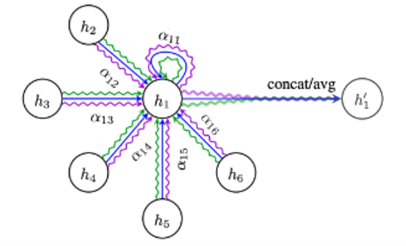Graph Attention Networks for Congestion and Mobility Prediction
Military / Coalition Issue
Network topology in military networks, especially in mobile battlefield environments, constantly changes requiring to dynamically adapt network control decisions, resource allocations and other policies. Such policies are often realized with the help of Machine Learning (ML) which is a promising approach that can perform better than the traditional model+optimize methods. Yet, the aforementioned network dynamics bring significant challenges to the application of ML in these networks. Most of the ML models would require to be re-trained from scratch every time the topology of the network changes, e.g., when a group of mobile nodes fragment from the rest of the network thereby changing the network topology. Such re-training is not only time-consuming and computation-costly but in many cases impossible as training data may not be available/easy to access. Ideally, we would like the ML model to be robust to network topology changes and fragmentation events.
Core idea and key achievements
With the Software Defined Coalition (SDC) architecture proposed in the DAIS program, information about the status of the network (e.g., traffic loads, resource availability) and the mission (e.g., accomplishment of goals) are aggregated at a logically-centralized network entity, the SDC controller. Such information constitutes valuable data that typically ML methods applied in this context use to train their models. The SDC controllers have powerful computation resources and can leverage advanced ML methods such as Graph Attention (GAT) neural networks for model training. The unique benefit of GAT is that, once trained, a set of attention coefficient values (αij in the figure) are defined which are useful to make predictions even if the network topology changes. This generalizability property of GATs provides the desirable level of robustness to the ML model.

Key achievements include:
- Robust machine learning models based on the Graph Attention (GAT) neural network architecture that are applicable even when network topology changes – no retraining of new models required.
- Application of GAT method for two different use-cases; prediction of network traffic dynamics and mobility of nodes/fragmentation events.
- Interpretability of decisions made by the neural network by explaining the attention coefficient values.
Implications for Defence
The GAT method will allow the development of robust ML models that are not affected by network topology changes and fragmentation events. This way, network operations can continue, and smart predictions and decisions can be still made without interruptions for model re-training.
Readiness & alternative Defence uses
TRL 2/3. Software prototype under preparation for the final DAIS meeting.
Resources and references - Needs URL updates
Related publications include:
- Traffic prediction
- Qin, Qiaofeng, et al. “Learning-aided SDC control in mobile ad hoc networks.” Artificial Intelligence and Machine Learning for Multi-Domain Operations Applications III. Vol. 11746. International Society for Optics and Photonics, 2021.
Organisations
Yale University, IBM US, IBM UK, ARL